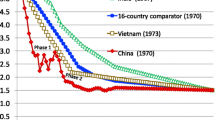Abstract
Traditional family planning's emphasis on manipulating the total fertility rate often results in erratic number of births which disrupts school enrollment and labor supply. Fixing total annual births to a permanently lower level will avoid such repeated disruptions and can eventually lead to a lower stationary population with annual deaths equal to the fixed annual births. If allocation of the fixed birth quotas is conditional upon deaths, each death can be converted to a variable number of inheritable and tradable birth quotas. Tradable birth coupons allow families to have the number of children they want and can afford within the overall fixed birth quotas. Inheritable birth quotas provide incentive for higher old-age mortality and consequently less aging in a declining population.
Similar content being viewed by others
References
Agence France Presse (1994). Chinese polls show support for euthanasia, October 28.
Agence France Presse (1994). One-child policy threatens alarming social impact, July 6.
Boulding, K. E. (1964). The meaning of the twentieth century. New York: Harper & Row.
Business Week (1995). The ultimate mousetrap, July 31: 87.
Cohen, J. E. (1995). How many people can the earth support? New York: W. W. Norton & Co.
Fung, K. K. (1993). Dying for money: overcoming moral hazard in terminal illnesses through compensated physician-assisted death, The American Journal of Economics and Sociology 52(3): 275–88.
Goldstein, A. & Goldstein, S. (1986). The challenge of an aging population: the case of the Republic of China, Research on Aging 8(2): 188–89.
New York Times (1994). China's mania for baby-boys creates surplus of bachelors, August 16. Reported by Philip Shenon.
Tabulation on the 1990 Population Census of the People's Republic of China, Volumes 1–4. Population Census Office under the State Council and Department of Population Statistics, State Statistical Bureau, People's Republic of China.
US News and World Report (1994). Family planning, at a price–China's tough population policy works, but critics say it hurts women, September 19. Reported by Susan V. Lawrence.
Wilson, E. (1978). On human nature. Cambridge, MA: Harvard University Press.
Author information
Authors and Affiliations
Rights and permissions
About this article
Cite this article
Fung, K. How many children? – Fixing total annual births as a population control policy. Population Research and Policy Review 17, 403–420 (1998). https://doi.org/10.1023/A:1006050225951
Issue Date:
DOI: https://doi.org/10.1023/A:1006050225951




